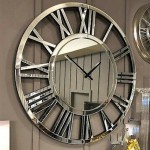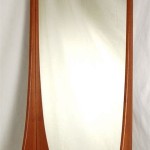How To Hang A Vanity Mirror On The Wall
Hanging a vanity mirror is a common home improvement task that can significantly enhance the aesthetic and functionality of a bathroom or dressing area. While it might appear straightforward, proper planning, accurate measurements, and the correct tools are crucial for ensuring the mirror is securely mounted and level. This article provides a comprehensive guide to hanging a vanity mirror on the wall, covering preparatory steps, installation techniques, and safety considerations.
1. Preparation: Gathering Materials and Assessing the Wall
Before commencing the installation, gather all necessary materials and tools. A well-prepared workspace minimizes interruptions and ensures a smoother process. Consider the following list:
*Vanity Mirror: Ensure the mirror is in good condition and free from any defects. Note its dimensions and weight for accurate planning.
*Measuring Tape: Accurate measurements are essential for proper placement and alignment.
*Level: A level guarantees that the mirror hangs straight and prevents a crooked appearance.
*Pencil: A pencil is used to mark the desired location of the mirror and the placement of mounting hardware.
*Stud Finder: A stud finder helps locate wall studs, providing secure anchor points for heavier mirrors. If no studs are available, wall anchors are necessary.
*Drill: A drill is needed to create pilot holes for screws and to install wall anchors, if required. Select drill bits appropriate for the wall material (drywall, plaster, tile, etc.).
*Screwdriver: A screwdriver, either manual or powered, is used to tighten the screws that secure the mirror to the wall.
*Wall Anchors: Wall anchors are necessary if the mirror cannot be mounted directly into wall studs. Choose anchors rated for the weight of the mirror.
*Safety Glasses: Safety glasses protect the eyes from debris during drilling and installation.
*Gloves: Gloves provide a better grip and protect hands from sharp edges.
*Drop Cloth or Protective Covering: A drop cloth protects the floor from dust and debris.
After gathering the necessary materials, assess the wall where the mirror will be mounted. Determine the wall's composition (drywall, plaster, tile, etc.) and locate any underlying studs using a stud finder. The presence of studs significantly affects the installation process, as they offer a more secure mounting point than drywall alone.
If studs are not available in the desired location, carefully select appropriate wall anchors. Different types of wall anchors are designed for varying weight capacities and wall materials. Consult the anchor manufacturer's specifications to ensure they can adequately support the weight of the mirror. Avoid using cheap or generic wall anchors, as they may fail under the weight of the mirror, leading to potential damage and injury.
Consider any existing plumbing or electrical wiring behind the wall. Avoid drilling into areas where pipes or wires may be present. If unsure, consult with a qualified professional before proceeding.
2. Installation Techniques: Marking, Drilling, and Mounting
With the wall assessed and materials prepared, the installation process can commence. This stage involves precise marking, careful drilling, and secure mounting of the mirror.
*Marking the Mirror's Location: Use a measuring tape and level to determine the desired location of the mirror on the wall. Mark the top corners of the mirror with a pencil. These marks serve as a visual guide during installation.
*Determining Mounting Hardware Placement: Refer to the mirror's mounting hardware instructions. Measure the distance between the mounting holes or brackets on the back of the mirror. Transfer these measurements onto the wall, ensuring the marks are level. These marks indicate where the screws or anchors will be placed.
*Drilling Pilot Holes: If mounting into wall studs, drill pilot holes at the marked locations. The pilot holes should be slightly smaller than the diameter of the screws being used. If using wall anchors, follow the manufacturer's instructions for hole size and drilling depth. It is crucial to drill straight and avoid angling the drill bit, as this can compromise the anchor's holding power.
*Installing Wall Anchors (If Necessary): If studs are not available, install wall anchors into the drilled holes. Ensure the anchors are flush with the wall surface. The type of anchor used will dictate the installation method. Some anchors require tapping with a hammer, while others require tightening with a screwdriver.
*Mounting the Mirror: Carefully align the mirror with the drilled holes or installed anchors. Insert screws through the mirror's mounting hardware and into the pilot holes or wall anchors. Tighten the screws gradually, ensuring the mirror remains level. Avoid over-tightening the screws, as this can damage the wall or the mirror's mounting hardware.
*Checking Alignment: After the mirror is mounted, use a level to verify that it is hanging straight. If necessary, make minor adjustments to the screws to achieve perfect alignment. Once satisfied, tighten the screws securely.
For heavier mirrors, consider using multiple mounting points to distribute the weight evenly. This reduces the risk of the mirror pulling away from the wall and enhances its stability.
If mounting a mirror on a tiled wall, use specialized drill bits designed for tile. These bits prevent cracking or chipping the tile during drilling. Apply masking tape to the tile surface to further protect it from damage. Drill slowly and steadily, applying minimal pressure.
3. Safety Considerations: Handling Glass and Preventing Accidents
Working with mirrors involves inherent safety risks, particularly due to the fragility of glass and the potential for sharp edges. Adhering to safety guidelines is paramount to prevent accidents and injuries.
*Handling Glass with Care: Always handle mirrors with care to avoid breakage. Wear gloves to protect hands from sharp edges. If a mirror breaks, do not attempt to clean up the broken glass with bare hands. Use a broom and dustpan to collect the larger pieces, and then use a wet cloth to wipe up any remaining shards.
*Eye Protection: Wear safety glasses to protect the eyes from flying debris during drilling and installation. Small particles of drywall, plaster, or tile can cause serious eye injuries.
*Weight Considerations: Be mindful of the mirror's weight. Heavy mirrors require stronger mounting hardware and may require assistance from another person during installation. Never attempt to lift or mount a mirror that is beyond your physical capabilities.
*Electrical Safety: If working near electrical outlets or wiring, turn off the power at the circuit breaker before commencing any work. Use caution when drilling or screwing near electrical components. If unsure about the location of wiring, consult a qualified electrician.
*Ladder Safety: If using a ladder to reach higher areas of the wall, ensure the ladder is stable and placed on a level surface. Avoid overreaching or leaning too far to one side. Have someone spot you while you are on the ladder.
*Proper Disposal: Dispose of broken glass and used wall anchors properly. Wrap broken glass securely in newspaper or cardboard before placing it in the trash to prevent injuries to sanitation workers.
Regularly inspect the mounted mirror for any signs of loosening or instability. If the mirror feels wobbly or the mounting hardware appears damaged, tighten the screws or replace the anchors immediately. Ignoring these issues can lead to the mirror falling and causing damage or injury.
When selecting screws and wall anchors, prioritize quality and durability. Avoid using cheap or generic components, as they are more likely to fail under stress. Invest in reputable brands that are known for their strength and reliability.
Properly securing a vanity mirror to the wall requires careful planning, accurate execution, and adherence to safety guidelines. By following these steps and taking necessary precautions, one can confidently install a vanity mirror and enhance the functionality and aesthetics of any space.

Tutorial How To Hang A Bathroom Mirror The Diy Playbook

How To Install A Mirror Without Frame Merrypad

How To Hang A Heavy Mirror Diy Family Handyman

3 Ways To Hang A Vanity Mirror Wikihow

How To Hang A Mirror Glass Genius

How To Hang A Mirror On Tile Wall Remington Avenue

How To Hang A Bathroom Mirror Over Tile Wainscoting Mimzy Company

How To Hang Mirrors On Tile 3 Ways A Bonus The Palette Muse

How To Make A Modern Sunrise Floating Mirror Shelf Remodelaholic

How High To Hang A Vanity Mirror Sparrow Stoll








